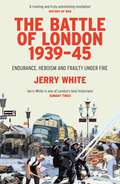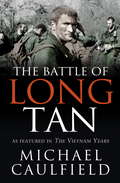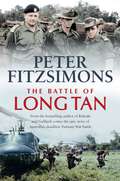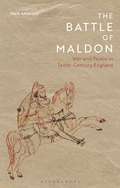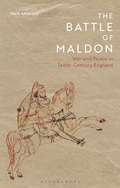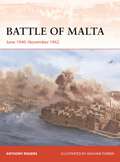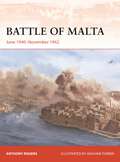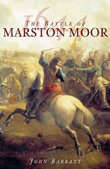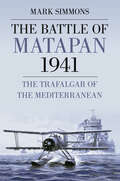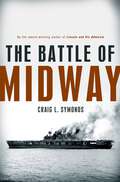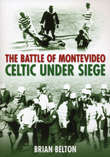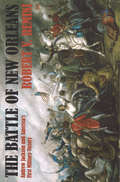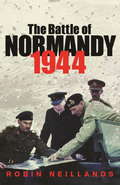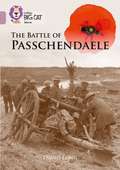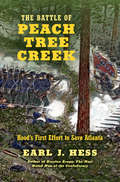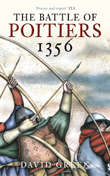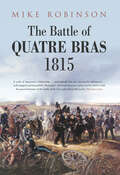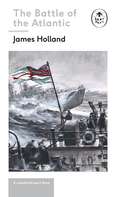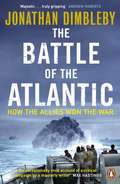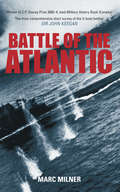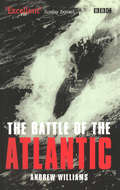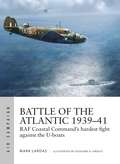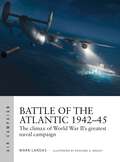- Table View
- List View
The Battle of London 1939-45: Endurance, Heroism and Frailty Under Fire
by Jerry WhiteThe definitive social history of London in the Blitz, which transformed life in the capital beyond recognition.For Londoners the six long years of the Second World War were a time of almost constant anxiety, disruption, deprivation and sacrifice. The Blitz began in earnest in September 1940 and from then on, for prolonged periods, London was under sustained aerial bombardment by night and by day. Throughout the war, the capital was the nation's front line; by its end, 30,000 Londoners had lost their lives.Yet if the bombing defined the era for those who lived through it, the months of terror were outnumbered by those spent knitting together the fabric of daily life at work, in the home, on the allotment, in the cinema or theatre and, not least, standing in those interminable queues for daily necessities that were such a feature of London's war. Much has been written about 'the Myth of the Blitz' but in this riveting social history, Jerry White has unearthed what actually happened during those tempestuous years, getting close up to the daily lives of ordinary people, telling the story through their own voices. At the end of it all, the Battle of London was won not on the playing fields of Eton but in the playgrounds of a thousand council elementary schools across the capital.
The Battle of Long Tan: As featured in The Vietnam Years
by Michael CaulfieldThe truth about the battle that came to define our Vietnam War - from the men who were there.18th August, 1966. 1pm…D Company entered the plantation. They thought that, if they were lucky, they were closing in on perhaps 30 or 40 VC. They were horribly wrong.Over twelve long, bloody and brutal hours, 105 Australian soldiers and three New Zealanders fought off mortar attacks and heavy machine-gun fire, unaware they were facing up to 2500 Viet Cong and North Vietnamese forces. The first major battle of the war for the Australians, our men showed extraordinary courage and, against all odds, they triumphed – although the Vietnamese didn't admit this for another forty years.In The Battle of Long Tan, Caulfield takes us through that hellish day in the Long Tan rubber plantation, combining gripping first-hand accounts from eleven of the men who fought with an authoritative overview of the battle itself – from headquarters to the men in the field.This is as close as you'll get to being there.Michael Caulfield has worked as a composer, musician, TV and film producer, and director. He was the executive producer of the ABC TV series Australians at War. His books with Hachette Australia include The Vietnam Years, War behind the Wire and Voices of War.
The Battle of Long Tan
by Peter FitzSimonsFrom the bestselling author of Kokoda and Gallipoli comes the epic story of Australia's deadliest Vietnam War battle.4.31 pm: Enemy [on] left flank. Could be serious.5.01 pm: Enemy ... penetrating both flanks and to north and south.5.02: Running short of ammo. Require drop through trees.It was the afternoon of 18 August 1966, hot, humid with grey monsoonal skies. D Company, 6RAR were four kilometres east of their Nui Dat base, on patrol in a rubber plantation not far from the abandoned village of Long Tan. A day after their base had suffered a mortar strike, they were looking for Viet Cong soldiers. Then - just when they were least expecting - they found them. Under withering fire, some Diggers perished, some were grievously wounded, the rest fought on, as they remained under sustained attack.For hours these men fought for their lives against the enemy onslaught. The skies opened and the rain fell as ferocious mortar and automatic fire pinned them down. Snipers shot at close quarters from the trees that surrounded them. The Aussie, Kiwi and Yankee artillery batteries knew it was up to them but, outnumbered and running out of ammunition they fired, loaded, fired as Viet Cong and North Vietnamese Army forces just kept coming. And coming.Their only hope was if Armoured Personnel Carriers (APCs) could reach them before they were wiped out. The APCs did their best but low cloud and thunderstorms meant air support was stalled. A daring helicopter resupply mission was suggested but who would want to fly that? The odds against this small force were monumental...By far the deadliest battle for Australian forces in Vietnam, the Battle of Long Tan has a proud place in the annals of Australian military history - and every ANZAC who fought there could hold his head high.Peter FitzSimons, Australia's greatest storyteller, tells the real story of this classic battle. He reveals the horror, the bravery, the wins and the losses that faced our soldiers. He brings to life the personal stories of the men who fought, the events leading up to that memorable battle and the long war that followed, and the political decisions made in the halls of power that sealed their fates. The Battle of Long Tan is an engrossing and powerful history that shows the costs of war never end.
The Battle of Maldon: War and Peace in Tenth-Century England
by Mark AthertonDepicting one of the defining conflicts of tenth-century England, The Battle of Maldon immortalises the bloody fight that took place along the banks of the tidal river Blackwater in 991, poignantly expressing the lore and language of a determined nation faced with the advance of a ruthless and relentless enemy. But, as Mark Atherton reveals, The Battle of Maldon is more than a heroic tale designed to inspire courage and unity in a time of crisis: rather, it celebrates ideals of loyalty and friendship and commemorates an event which changed the face of English culture. Using Atherton's own vivid and illuminating translations from Old English, The Battle of Maldon: War and Peace in Tenth-Century England evokes the chaotic ebb and flow of the battle while also placing 'Maldon' in the context of its age. Seeking to reconstruct the way of life, the spirituality and the worldview of the original audience, Atherton examines how and why the poem encouraged its readers to relive the visceral experience of battle for themselves. With this exciting study, Atherton provides an authoritative treatment of this iconic text, its history and its legacy. As such, this important book will be a vital resource for all readers of Old English literature and early medieval history.
The Battle of Maldon: War and Peace in Tenth-Century England
by Mark AthertonDepicting one of the defining conflicts of tenth-century England, The Battle of Maldon immortalises the bloody fight that took place along the banks of the tidal river Blackwater in 991, poignantly expressing the lore and language of a determined nation faced with the advance of a ruthless and relentless enemy. But, as Mark Atherton reveals, The Battle of Maldon is more than a heroic tale designed to inspire courage and unity in a time of crisis: rather, it celebrates ideals of loyalty and friendship and commemorates an event which changed the face of English culture. Using Atherton's own vivid and illuminating translations from Old English, The Battle of Maldon: War and Peace in Tenth-Century England evokes the chaotic ebb and flow of the battle while also placing 'Maldon' in the context of its age. Seeking to reconstruct the way of life, the spirituality and the worldview of the original audience, Atherton examines how and why the poem encouraged its readers to relive the visceral experience of battle for themselves. With this exciting study, Atherton provides an authoritative treatment of this iconic text, its history and its legacy. As such, this important book will be a vital resource for all readers of Old English literature and early medieval history.
Battle of Malta: June 1940–November 1942 (Campaign)
by Anthony RogersA detailed exploration of the land, sea and air units that defended Malta, and the repeated Axis attempts to bring the crucial Allied island fortress to its knees.On 11 June 1940, the British crown colony of Malta – which dominated the central Mediterranean and all-important sea routes to and from North Africa – was bombed for the first time by aircraft of the Italian Regia Aeronautica. The Italians were joined in their efforts by the German Luftwaffe in January 1941. Malta was effectively beleaguered for nearly two and a half years, dependent for survival on naval supply convoys and reliant for defence on often-outnumbered fighter aircraft and anti-aircraft guns. Anthony Rogers provides a retelling of these events, drawing on accounts from both sides. This work features carefully selected photographic images, some previously unpublished. Seven specially commissioned colour maps explore the stategic situation in the Mediterranean in this period, the military sectors into which Malta's defence was divided, and German minelaying operations around the island. The three stunning battlescene artworks and 3D BEVs show key events from the battle, including the 26 July 1941 German attack on the Grand Harbour, and the major Luftwaffe raid 21 March 1942.
Battle of Malta: June 1940–November 1942 (Campaign #381)
by Anthony RogersA detailed exploration of the land, sea and air units that defended Malta, and the repeated Axis attempts to bring the crucial Allied island fortress to its knees.On 11 June 1940, the British crown colony of Malta – which dominated the central Mediterranean and all-important sea routes to and from North Africa – was bombed for the first time by aircraft of the Italian Regia Aeronautica. The Italians were joined in their efforts by the German Luftwaffe in January 1941. Malta was effectively beleaguered for nearly two and a half years, dependent for survival on naval supply convoys and reliant for defence on often-outnumbered fighter aircraft and anti-aircraft guns. Anthony Rogers provides a retelling of these events, drawing on accounts from both sides. This work features carefully selected photographic images, some previously unpublished. Seven specially commissioned colour maps explore the stategic situation in the Mediterranean in this period, the military sectors into which Malta's defence was divided, and German minelaying operations around the island. The three stunning battlescene artworks and 3D BEVs show key events from the battle, including the 26 July 1941 German attack on the Grand Harbour, and the major Luftwaffe raid 21 March 1942.
The Battle of Marston Moor 1644
by John BarrattOn 2 July 1644, six miles from York, 18,000 Royalists led by Prince Rupert, the nephew of King Charles I, fought 27,000 Parliamentarians in an attempt to relieve the Royalist force besieged at York. He failed. The defeat was catastrophic and the North was lost to Parliamentarian troops. John Barratt looks afresh at the battle and explores the disagreements among the Royalist leaders that had a devastating effect on the outcome of the battle.
The Battle of Matapan 1941: The Trafalgar of the Mediterranean
by Mark SimmonsIn March 1941, the Royal navy scored one of the greatest one-sided victories against the Italian Fleet the Regia Marina at Matapan. It brought to an end six months of remarkable success for the Royal Navy in the Mediterranean. When France fell and Italy declared war on Britain, Admiral Dudley Pound had wanted to evacuate the Mediterranean altogether and concentrate on home defence. Churchill overruled him, regarding such a move as the death knell of the British Empire. His decision made the Mediterranean theatre the focus of British land operations for four years, reliant on the Navy. In Admiral Andrew Cunningham, Churchill had a fleet commander in the Mediterranean who would miss no chance of hounding the enemy. Affectionately known as A.B.C. by his men, Cunningham was salty in his language, intolerant of fools and a master of tactics. In 'The Battle of Matapan 1941: The Trafalgar of the Mediterranean', Mark Simmons explores the remarkable victories of Taranto and Matapan, as seen through the eyes of the men who manned the ships and flew the aircraft of the Mediterranean fleet.
The Battle of Midway (Pivotal Moments in American History)
by Craig L. SymondsThere are few moments in American history in which the course of events tipped so suddenly and so dramatically as at the Battle of Midway. At dawn of June 4, 1942, a rampaging Japanese navy ruled the Pacific. By sunset, their vaunted carrier force (the Kido Butai) had been sunk and their grip on the Pacific had been loosened forever. In this absolutely riveting account of a key moment in the history of World War II, one of America's leading naval historians, Craig L. Symonds paints an unforgettable portrait of ingenuity, courage, and sacrifice. Symonds begins with the arrival of Admiral Chester A. Nimitz at Pearl Harbor after the devastating Japanese attack, and describes the key events leading to the climactic battle, including both Coral Sea--the first battle in history against opposing carrier forces--and Jimmy Doolittle's daring raid of Tokyo. He focuses throughout on the people involved, offering telling portraits of Admirals Nimitz, Halsey, Spruance and numerous other Americans, as well as the leading Japanese figures, including the poker-loving Admiral Yamamoto. Indeed, Symonds sheds much light on the aspects of Japanese culture--such as their single-minded devotion to combat, which led to poorly armored planes and inadequate fire-safety measures on their ships--that contributed to their defeat. The author's account of the battle itself is masterful, weaving together the many disparate threads of attack--attacks which failed in the early going--that ultimately created a five-minute window in which three of the four Japanese carriers were mortally wounded, changing the course of the Pacific war in an eye-blink. Symonds is the first historian to argue that the victory at Midway was not simply a matter of luck, pointing out that Nimitz had equal forces, superior intelligence, and the element of surprise. Nimitz had a strong hand, Symonds concludes, and he rightly expected to win.
The Battle of Midway (Pivotal Moments in American History)
by Craig L. SymondsThere are few moments in American history in which the course of events tipped so suddenly and so dramatically as at the Battle of Midway. At dawn of June 4, 1942, a rampaging Japanese navy ruled the Pacific. By sunset, their vaunted carrier force (the Kido Butai) had been sunk and their grip on the Pacific had been loosened forever. In this absolutely riveting account of a key moment in the history of World War II, one of America's leading naval historians, Craig L. Symonds paints an unforgettable portrait of ingenuity, courage, and sacrifice. Symonds begins with the arrival of Admiral Chester A. Nimitz at Pearl Harbor after the devastating Japanese attack, and describes the key events leading to the climactic battle, including both Coral Sea--the first battle in history against opposing carrier forces--and Jimmy Doolittle's daring raid of Tokyo. He focuses throughout on the people involved, offering telling portraits of Admirals Nimitz, Halsey, Spruance and numerous other Americans, as well as the leading Japanese figures, including the poker-loving Admiral Yamamoto. Indeed, Symonds sheds much light on the aspects of Japanese culture--such as their single-minded devotion to combat, which led to poorly armored planes and inadequate fire-safety measures on their ships--that contributed to their defeat. The author's account of the battle itself is masterful, weaving together the many disparate threads of attack--attacks which failed in the early going--that ultimately created a five-minute window in which three of the four Japanese carriers were mortally wounded, changing the course of the Pacific war in an eye-blink. Symonds is the first historian to argue that the victory at Midway was not simply a matter of luck, pointing out that Nimitz had equal forces, superior intelligence, and the element of surprise. Nimitz had a strong hand, Symonds concludes, and he rightly expected to win.
The Battle of Montevideo: Celtic Under Siege
by Brian BeltonThe Battle of Montevideo presents the compelling story of football's most violent match, the World Club Championship decider between Celtic and Racing Club of Buenos Aires in 1967.
Battle Of New Orleans: Andrew Jackson And America's First Military Victory
by Robert ReminiIn 1815 Britain's crack troops, fresh from the victories against Napoleon, were stunningly defeated near New Orleans by a ragtag army of citizen-soldiers under the commander they dubbed 'Old Hickory', Andrew Jackson. It was this battle that defined the United States as a military power to be reckoned with and an independent democracy here to stay.A happenstance coalition of militiamen, regulars, untrained frontiersmen, free blacks, pirates, Indians and townspeople - marching to 'Yankee Doodle' and 'La Marseillaise' - inhabit The Battle of New Orleans in a rich array of colourful scenes. Swashbuckling Jean Lafitte and his privateers. The proud, reckless British General Pakenham and his miserable men ferried across a Louisiana lake in a Gulf storm. The agile Choctaw and Tennessee 'dirty shirt' sharpshooters who made a sport of picking off redcoat sentries by night. And Jackson himself - tall, gaunt, shrewd, by turns gentle and furious, declaring 'I will smash them, so help me God!' Robert Remini's vivid evocation of this glorious, improbable victory is more than a masterful military history. It proves that only after the Battle of new Orleans could Americans say with confidence that they were Americans, not subjects of a foreign power. It was the triumph that catapulted a once-poor, uneducated orphan boy into the White House and forged a collection of ex-colonies and dissenters into a nation.
The Battle of Normandy 1944: 1944 The Final Verdict (Sven Hassel War Classics)
by Robin NeillandsA fresh and incisive examination of one of the Second World War's crucial campaigns, the battle for Normandy in the months after D-Day.What happened to the Allied armies in Normandy in the months after D-Day, 1944? Why, after the initial success of the landings, did their advance stall a few miles inland from the beaches? Why did the British take so long to capture Caen? Why did the US infantry struggle so much in the bocage south of Omaha beach? Who was right about the conduct of the land campaign - Eisenhower or Montgomery? How did the Germans, deprived of air support, manage to hold off such a massive Allied force for more than two months? And if Enigma was allowing the Allies to read German battleplans, why did things go wrong as often as they did?THE BATTLE OF NORMANDY re-examines the demands and difficulties of the campaign and sheds new light on both with the aid of accounts from veterans on both sides. (Oral history forms a large part of the book.) It also analyses in detail the plans and performance of the commanders involved: Eisenhower, Bradley, Patton, Montgomery, Crerar and, of course, Rommel. Controversial and at times catastrophic, the Battle of Normandy was the last great set-piece battle in history and is long overdue for reassessment.
The Battle Of Passchendaele: Band 18/Pearl (PDF) (Collins Big Cat Ser. (PDF))
by David Long Collins Uk Staff Collins Big CatIn 1917, during World War I, the battle of Passchendaele was fought on the Western Front in Belgium. Find out why the battle was important and what life was like for the soldiers who fought and died there. • Pearl/Band 18 books offer fluent readers a complex, substantial text with challenging themes to facilitate sustained comprehension, bridging the gap between a reading programme and longer chapter books. • Text type: an information book • Curriculum links: history
The Battle of Peach Tree Creek: Hood's First Effort to Save Atlanta (Civil War America)
by Earl J. HessOn July 20, 1864, the Civil War struggle for Atlanta reached a pivotal moment. As William T. Sherman's Union forces came ever nearer the city, the defending Confederate Army of Tennessee replaced its commanding general, removing Joseph E. Johnston and elevating John Bell Hood. This decision stunned and demoralized Confederate troops just when Hood was compelled to take the offensive against the approaching Federals. Attacking northward from Atlanta's defenses, Hood's men struck George H. Thomas's Army of the Cumberland just after it crossed Peach Tree Creek on July 20. Initially taken by surprise, the Federals fought back with spirit and nullified all the advantages the Confederates first enjoyed. As a result, the Federals achieved a remarkable defensive victory. Offering new and definitive interpretations of the battle's place within the Atlanta campaign, Earl J. Hess describes how several Confederate regiments and brigades made a pretense of advancing but then stopped partway to the objective and took cover for the rest of the afternoon on July 20. Hess shows that morale played an unusually important role in determining the outcome at Peach Tree Creek--a soured mood among the Confederates and overwhelming confidence among the Federals spelled disaster for one side and victory for the other.
The Battle of Poitiers 1356
by David GreenThe victory at Poitiers by an English force outnumbered two-to-one, led by Edward the Black Prince on 19th September 1356 was one of the most significant of the Hundred Years War. The consequences of the battle resonated throughout the remainder of the century and influenced the war to its end in 1453. David Green has researched the battle and the raids that preceded it exhaustively and details the strategy, tactics, arms and armour used by both sides. He reconstructs the battle using an array of contemporary sources and discusses the protagonists, the siting, course and outcome of the encounter and considers the implications of the capture of King Jean II of France and many of the most important members of the French nobility.
The Battle of Quatre Bras 1815 (History Press Ser.)
by Mike RobinsonQuatre Bras was the battle that turned a campaign – a tale of triumph and disaster. The Battle of Quatre Bras 1815 is not only a significant addition to the written history of the Napoleonic Wars, it is also the first English language account to focus solely on this crucial battle of the Waterloo campaign. Mike Robinson’s compelling account is based on extensive original research and includes many unpublished personal accounts from all the participating nations. The author combines this testimony with an unparalleled study of the topography of the battlefield and deep knowledge of Napoleonic warfare to tell the story of a battle where commanders made errors of omission and commission and where cowardice rubbed shoulders with heroism. Above all, it is the story of the intense human experience of those who participated in the events of those two fateful days in June 1815.
Battle of the Atlantic: (WW2 #3) (The Ladybird Expert Series)
by Keith Burns James HollandPart of the ALL-NEW Ladybird Expert series.Find out about WWII's longest battle. This is an accessible, insightful and authoritative account of the naval campaign that kept supply lines open and enabled Britain to continue to fight. Historian, author and broadcaster James Holland draws on the latest research and interviews with participants to bring colour, detail and a fresh perspective to the story of how the siege of Europe was broken.Inside, you'll discover exactly what happened in the Battle of the Atlantic. Ships, submarines and aircraft fought a bitter war that saw the deaths of over 100,000 servicemen and civilians. What's inside?- The tragic demise of SS Athenia- The power of U-boats- Advantages of Britain's naval experience- German naval Enigma codes- The rapid development of advancing weaponry- And much more . . . Written by the leading lights and most outstanding communicators in their fields, the Ladybird Expert books provide clear, accessible and authoritative introductions to subjects drawn from science, history and culture.For an adult readership, the Ladybird Expert series is produced in the same iconic small hardback format pioneered by the original Ladybirds. Each beautifully illustrated book features the first new illustrations produced in the original Ladybird style for nearly forty years.
The Battle of the Atlantic: How the Allies Won the War
by Jonathan DimblebyA gripping tale that transforms our understanding of the Second World WarThe Battle of the Atlantic was - though often overlooked - crucial to victory in the Second World War. If the German U-boats had prevailed, the maritime artery across the Atlantic would have been severed. Mass hunger would have consumed Britain, and the Allied armies would have been prevented from joining in the invasion of Europe. There would have been no D-Day.Through fascinating contemporary diaries and letters, from the leaders and from the sailors on all sides, Jonathan Dimbleby creates a thrilling narrative that uniquely places the campaign in the context of the entire Second World War. Challenging conventional wisdom on the use of intelligence and on Churchill's bombing campaign, The Battle of the Atlantic tells the epic story of the decisions that led to victory, and the horror and humanity of life on those perilous seas.
Battle of the Atlantic (Revealing History Ser.)
by Marc MilnerWorld War II was only a few hours old when the Battle of the Atlantic, the longest campaign of the Second World War and the most complex submarine war in history, began with the sinking of the unarmed passenger liner Athenia by the German submarine U30. Based on the mastery of the latest research and written from a mid-Atlantic - rather than the traditional Anglo-centric - perspective, Marc Milner focuses on the confrontation between opposing forces and the attacks on Allied shipping that lay at the heart of the six-year struggle. Against the backdrop of the battle for the Atlantic lifeline he charts the fascinating development of U-boats and the techniques used by the Allies to suppress and destroy these stealth weapons.
The Battle Of The Atlantic: The Allies' Submarine Fight Against Hitler's Gray Wolves Of The Sea (Art Of Mentoring Ser.)
by Andrew WilliamsFrom 1939 until 1942, Hitler's U-boats - his 'grey wolves' - threatened to accomplish what his air force had hitherto been unable to achieve: to starve Britain into submission. The struggle for control of the Atlantic was to become the longest, and one of the most bitterly fought campaigns of World War II. For Winston Churchill it was 'the only thing that ever really frightened me during the war'. During the course of five bloody and uncertain years, Britain and her Allies lost more than fifty thousand seamen and fifteen million tons of shipping protecting this lifeline. In 'The Battle of the Atlantic', Andrew Williams vividly describes this intense and strategically vital campaign in the fight for Allied victory. '...an excellent book.' Sunday Express
Battle of the Atlantic 1939–41: RAF Coastal Command's hardest fight against the U-boats (Air Campaign #15)
by Mark LardasAt the start of World War II, few thought the U-boat would be as devastating as it proved to be. But convoys and sonar-equipped escorts proved inadequate to defend the Allies' merchantmen, and the RAF's only offensive weapon was the anti-submarine warfare (ASW) aircraft. For RAF Coastal Command, the first two years of the war were the hardest. Although starved of resources, operating with outdated aircraft and often useless weaponry, they were still the only force that could take the fight to the U-boats. But in these two years, the RAF learned what it needed to win the Battle of the Atlantic. Gradually developing new tactics and technology, such as airborne radar, signals intelligence, and effective weaponry, the Allies ended 1941 in a position to defeat Dönitz's growing fleet of U-boats. This book, the first of two volumes, explains the fascinating history of how the RAF kept the convoys alive against the odds, and developed the force that would prevail in the climactic battles of 1942 and 1943.
Battle of the Atlantic 1939–41: RAF Coastal Command's hardest fight against the U-boats (Air Campaign #15)
by Mark LardasAt the start of World War II, few thought the U-boat would be as devastating as it proved to be. But convoys and sonar-equipped escorts proved inadequate to defend the Allies' merchantmen, and the RAF's only offensive weapon was the anti-submarine warfare (ASW) aircraft. For RAF Coastal Command, the first two years of the war were the hardest. Although starved of resources, operating with outdated aircraft and often useless weaponry, they were still the only force that could take the fight to the U-boats. But in these two years, the RAF learned what it needed to win the Battle of the Atlantic. Gradually developing new tactics and technology, such as airborne radar, signals intelligence, and effective weaponry, the Allies ended 1941 in a position to defeat Dönitz's growing fleet of U-boats. This book, the first of two volumes, explains the fascinating history of how the RAF kept the convoys alive against the odds, and developed the force that would prevail in the climactic battles of 1942 and 1943.
Battle of the Atlantic 1942–45: The climax of World War II’s greatest naval campaign (Air Campaign)
by Mark LardasAs 1942 opened, both Nazi Germany and the Allies were ready for the climactic battles of the Atlantic to begin. Germany had 91 operational U-boats, and over 150 in training or trials. Production for 1942–44 was planned to exceed 200 boats annually. Karl Dönitz, running the Kriegsmarine's U-boat arm, would finally have the numbers needed to run the tonnage war he wanted against the Allies.Meanwhile, the British had, at last, assembled the solution to the U-boat peril. Its weapons and detection systems had improved to the stage that maritime patrol aircraft could launch deadly attacks on U-boats day and night. Airborne radar, Leigh lights, Magnetic Anomaly Detection (MAD) and the Fido homing torpedo all turned the anti-submarine warfare (ASW) aircraft into a submarine-killer, while shore and ship-based technologies such as high-frequency direction finding and signals intelligence could now help aircraft find enemy U-boats. Following its entry into the war in 1941, the United States had also thrown its industrial muscle behind the campaign, supplying VLR Liberator bombers to the RAF and escort carriers to the Royal Navy. The US Navy also operated anti-submarine patrol blimps and VLR aircraft in the southern and western Atlantic, and sent its own escort carriers to guard convoys.This book, the second of two volumes, explores the climactic events of the Battle of the Atlantic, and reveals how air power – both maritime patrol aircraft and carrier aircraft – ultimately proved to be the Allies' most important weapon in one of the most bitterly fought naval campaigns of World War II.
